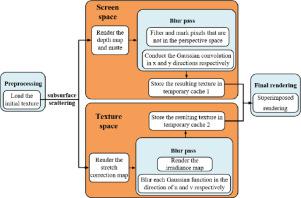Computers & Graphics ( IF 2.5 ) Pub Date : 2021-06-16 , DOI: 10.1016/j.cag.2021.06.003 Guanhui Guo , Yanni Zou , Peter X. Liu

|
High fidelity display has a big impact on the user’s sense of immersion in virtual surgery. To achieve a high degree of visual realism, we propose a new subsurface scattering method, which is based on screen-space and texture-space and an improved two-layer surface reflection model, for living soft tissue rendering. The method can be described as a two-step strategy. First, the subsurface scattering in the screen space is computed. The biggest difference from traditional methods is that the back light information stored in the irradiance map of the texture space and the diffusion profile in the dipole model are used to calculate the subsurface scattering distribution formed by the light from the back of the object, which can render more rich details. Second, considering that the living soft tissues are usually covered with a thin layer of mucus, a mucus texture is mapped to the soft tissues as the second layer texture and an improved two-layer surface reflection model is proposed to render the mucus. Moreover, to show the viscosity and smoothness of the mucus, the calculation of highlight component is used in our model, which further enhances the reality of living soft tissue. Experimental results show that our method outperforms the two traditional methods of subsurface scattering based on texture space and screen space, and the rendering time of the proposed two-layer surface reflection model is 2/3 of that of the traditional model. We conducted a survey on the fidelity of soft tissues rendered using different algorithms, and the professional surgeons (60%-85%) thought that the rendered soft tissue with our method is more consistent with the characteristics of the in vivo soft tissues under a real surgical scene.
中文翻译:

一种基于多空间的活体软组织渲染新算法
高保真显示对用户在虚拟手术中的沉浸感影响很大。为了实现高度的视觉真实感,我们提出了一种新的次表面散射方法,该方法基于屏幕空间和纹理空间以及改进的两层表面反射模型,用于活体软组织渲染。该方法可以描述为两步策略。首先,计算屏幕空间中的次表面散射。与传统方法最大的不同在于,利用纹理空间的辐照度图中存储的背光信息和偶极子模型中的漫射剖面来计算物体背面的光形成的次表面散射分布,可以渲染更丰富的细节。其次,考虑到活体软组织通常覆盖着一层薄薄的粘液,将粘液纹理映射到软组织作为第二层纹理,并提出改进的双层表面反射模型来渲染粘液。此外,为了显示粘液的粘度和光滑度,我们的模型中使用了高光分量的计算,这进一步增强了活体软组织的真实性。实验结果表明,我们的方法优于基于纹理空间和屏幕空间的两种传统次表面散射方法,所提出的两层表面反射模型的渲染时间是传统模型的2/3。我们对使用不同算法渲染的软组织的保真度进行了调查,











































 京公网安备 11010802027423号
京公网安备 11010802027423号